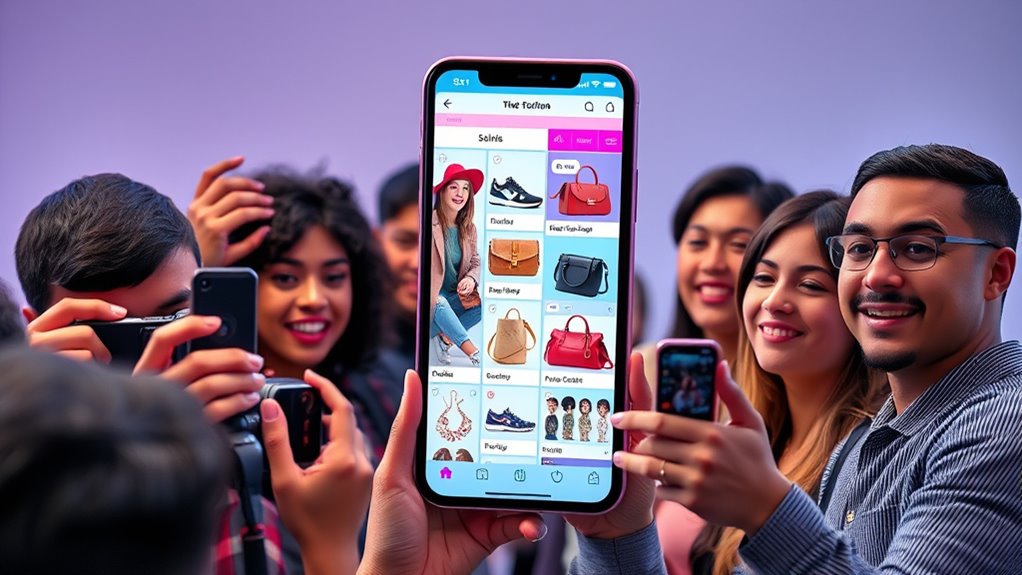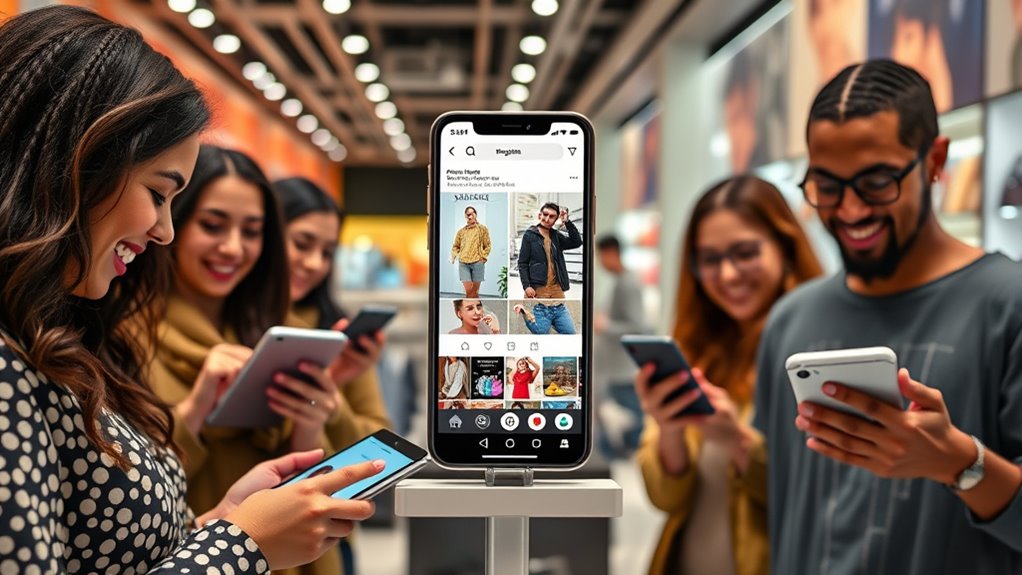To succeed with next-gen paid social strategies, focus on leveraging innovative shoppable media platforms like TikTok and Instagram, which offer seamless shopping experiences and viral content opportunities. Use engaging, interactive ads with AR, personalization, and influencer collaborations to boost authenticity and conversions. Data-driven insights help you optimize campaigns for better ROI, while new technologies like AI and voice commerce shape future shopping trends. Keep exploring these strategies to stay ahead and open more growth opportunities.
Key Takeaways
- Integrate seamless in-app shopping features like shoppable videos and storefronts on TikTok and Instagram for frictionless purchasing.
- Leverage influencer collaborations and user-generated content to boost authenticity and engagement in paid campaigns.
- Utilize advanced personalization techniques, including dynamic segmentation and real-time data, to deliver targeted, relevant ads.
- Incorporate interactive AR experiences and clickable media formats to enhance user engagement and drive conversions.
- Analyze data insights and KPIs continuously to optimize creative strategies, targeting, and overall campaign effectiveness.
The Rise of Shoppable Media: Transforming Consumer Engagement

Shoppable media has revolutionized how consumers interact with brands online. You now experience seamless shopping moments directly within social platforms, making discovery and purchase effortless. Influencer collaborations play a crucial role, as influencers showcase products in authentic, engaging ways that resonate with their followers. This method leverages user-generated content to further enhance credibility. This content acts as social proof, demonstrating real customers enjoying products, which builds trust and inspires others to buy. Additionally, user-generated content fuels social proof, showing real customers enjoying products, which builds trust and inspires others to buy. These strategies transform passive browsing into active engagement, shortening the path from interest to purchase. Moreover, incorporating energetic alignment into social media strategies can enhance consumer trust and brand loyalty, creating more meaningful connections. Implementing content personalization techniques can also help brands tailor their messages to specific audiences, increasing relevance and engagement. Incorporating space optimization techniques can also help brands utilize visual platforms more effectively, making content more appealing and organized. As a result, brands can create more personalized, interactive shopping experiences that foster loyalty and drive sales. Shoppable media keeps consumers connected and engaged, elevating social commerce to new heights.
Key Platforms Driving Social Commerce Innovation

Platforms like TikTok and Instagram are at the forefront of social commerce innovation, offering seamless shopping experiences. TikTok’s shopping features integrate product links directly into videos, making it easy for you to purchase while engaging. Meanwhile, Instagram’s robust shopping ecosystem allows you to browse, save, and buy products without leaving the app. Additionally, understanding Gold IRA options can provide a secure way to diversify your investment portfolio through alternative assets. Recognizing the importance of holistic living can further enhance your well-being by integrating home, heritage, and lifestyle choices. Consumers also benefit from retail hours, which ensure accessibility and convenience when shopping both online and in physical stores. Embracing emotional connections through social media can significantly influence purchasing decisions and foster brand loyalty. Incorporating TikTok’s algorithm insights can help brands tailor content to boost engagement and conversions.
TikTok’s Shopping Features
TikTok has rapidly become a trailblazer in social commerce by integrating innovative shopping features directly into its platform. Its seamless shopping tools enable users to browse and purchase products without leaving the app, making transactions effortless. TikTok trends play a significant role here, as viral challenges and trending sounds often spotlight products, boosting their visibility. Influencer collaborations further amplify these effects, as creators showcase and recommend items authentically, encouraging followers to buy. The platform’s shoppable videos and in-app storefronts create a frictionless shopping experience that taps into TikTok’s dynamic and highly engaged audience. By combining trend-driven content with influencer power, TikTok’s shopping features drive conversions and set new standards for social commerce innovation. Additionally, leveraging content accuracy can help brands ensure that product information remains trustworthy and appealing to consumers, while integrating home decor themes can enhance product relevance and inspire creative marketing strategies.
Instagram’s Shopping Ecosystem
Instagram has established itself as a leader in social commerce by developing an all-encompassing shopping ecosystem that seamlessly integrates commerce into users’ daily browsing. With Instagram Shopping, you can discover products directly within your feed, stories, and explore pages, making shopping effortless. Influencer Collaborations amplify this experience by showcasing authentic product endorsements that drive engagement and sales. This ecosystem encourages brands to:
- Tag products in posts and stories for instant shopping
- Collaborate with influencers to reach targeted audiences
- Use shoppable ads to boost conversions
- Utilize holistic approaches to health and wellness to maintain high deliverability and engagement across campaigns, as engaging content can also support emotional expression and creative promotion techniques. A well-integrated shopping environment not only enhances user experience but also encourages seamless social commerce transactions that benefit both consumers and brands. Leveraging data transfer rates and device compatibility can optimize the shopping experience across various platforms and devices.
Designing Interactive and Engaging Shoppable Ads

To make your shoppable ads stand out, focus on compelling visual appeal strategies that catch the eye instantly. Incorporate interactive elements like clickable product features or videos to keep viewers engaged, and tailor the experience with personalization techniques that resonate with your audience. By combining these approaches, you can create ads that are not only attractive but also highly effective at driving conversions. Additionally, understanding the benefits and effectiveness of eye patches can inspire innovative product showcases that highlight skin care solutions in your campaigns. Practicing mindfulness techniques such as visualization can help you craft more captivating creative concepts that resonate emotionally with viewers. Recognizing the importance of emotional support and open communication can also influence how you craft your messaging to foster trust and connection with your audience.
Visual Appeal Strategies
Creating visually appealing shoppable ads requires a strategic focus on design elements that capture attention and encourage interaction. Use color psychology to evoke emotions and influence purchasing decisions—bright reds energize, while calming blues build trust. Establish a clear visual hierarchy to guide viewers’ eyes toward key elements, such as the product or call-to-action. Keep your layout simple and focused to prevent clutter. Consider these ideas:
- Use bold, contrasting colors to highlight important areas
- Place the product prominently, with supporting visuals less dominant
- Incorporate whitespace to create balance and focus attention
- Incorporate popular media formats such as animated videos or GIFs to enhance engagement and make ads more memorable. Additionally, leveraging visual hierarchy principles can significantly improve the clarity and effectiveness of your ads, ensuring viewers immediately grasp the main message. Developing a growth mindset toward experimentation can help refine these design techniques for better results. Understanding the importance of personality traits in consumer behavior can also inform more targeted and persuasive ad designs, leading to increased interaction and conversions. Paying attention to consumer psychology can further optimize your visual appeal strategies by aligning your design with audience preferences and motivations.
Interactive Elements Integration
Building on strong visual design, integrating interactive elements transforms static ads into engaging shopping experiences. Augmented reality (AR) allows customers to virtually try products, making interactions more immersive and personal. Incorporate AR features that let users see how a piece of clothing fits or how furniture looks in their space, boosting confidence and conversions. Influencer collaborations further enhance engagement by adding authenticity; influencers can demonstrate product use within interactive ads, encouraging trust and sharing. These elements turn passive viewers into active participants, making the shopping journey memorable and fun. When executed effectively, interactive features like AR and influencer-led demonstrations create a seamless blend of entertainment and commerce, elevating your social media campaigns to next-generation standards.
Personalization Techniques
Personalization techniques are essential for designing interactive shoppable ads that truly resonate with your audience. By leveraging dynamic segmentation, you can tailor content based on user behavior, preferences, and demographics. Creating custom content ensures each viewer sees relevant products, increasing engagement and conversions. To enhance interactivity, consider these strategies:
- Use real-time data to dynamically adjust product recommendations
- Incorporate personalized visuals and messaging that reflect user interests
- Offer tailored discounts or promotions based on individual browsing history
These techniques make your ads more relevant and engaging, encouraging users to interact and convert. By focusing on personalized experiences, you build stronger connections and improve overall campaign performance in social commerce.
Leveraging Data and Analytics for Smarter Campaigns

By harnessing the power of data and analytics, you can make more informed decisions that drive effective social commerce campaigns. Data driven targeting allows you to reach the right audience with precision, increasing engagement and conversions. Use analytics optimization to continually refine your strategies, identifying which ads, creatives, and offers perform best. Analyzing metrics like click-through rates, conversion rates, and customer behavior helps you allocate budget more effectively and adjust messaging in real time. This approach minimizes wasted spend and maximizes ROI. When you leverage data insights, your campaigns become more agile and tailored to audience preferences, resulting in smarter spending and better results. In today’s competitive landscape, data-driven decision-making is essential for social commerce success.
Integrating Social Commerce Into Broader Marketing Strategies

Integrating social commerce into your broader marketing strategies guarantees that your efforts work together seamlessly to reach your goals. To succeed, focus on aligning channels and messaging, ensuring consistency across platforms. Influencer collaborations can amplify your reach and authenticity, creating a unified brand presence. Cross channel integration helps you deliver a cohesive experience, guiding users from awareness to purchase smoothly. Consider these key ideas:
- Coordinate influencer campaigns across social platforms for maximum impact
- Use data-driven insights to synchronize messaging and timing
- Create seamless shopping experiences by linking content, ads, and storefronts
Creative Best Practices for Seamless Shopping Experiences

To create seamless shopping experiences, you need to craft content that guides users effortlessly from discovery to purchase. Focus on compelling product storytelling that highlights key features and benefits, making it easy for users to connect emotionally with your offerings. Use visuals and messaging that reflect your brand’s voice consistently across all touchpoints, ensuring brand consistency enhances trust and recognition. Keep your content authentic, engaging, and easy to navigate, reducing friction at every step. Incorporate clear calls-to-action and seamless integrations that allow users to shop directly within the content without confusion. By aligning your creative elements with these best practices, you’ll create a cohesive experience that encourages conversions and builds lasting customer relationships.

To gauge your social commerce success, you need to track key performance indicators that matter most to your goals. Calculating your return on investment helps you understand whether your efforts are paying off. By focusing on these metrics, you can make smarter decisions to optimize your shoppable media strategies.
Key Performance Indicators
How do you determine whether your social commerce efforts are truly paying off? You need clear KPIs to gauge success. Focus on metrics like customer loyalty, which shows repeat engagement, and the impact of brand storytelling on conversions. Tracking these indicators helps you understand what resonates with your audience.
Key KPIs include:
- Conversion rates from shoppable posts
- Engagement levels and comments on brand storytelling
- Customer retention and repeat purchases
These metrics reveal how well your campaigns foster loyalty and deepen brand connection. By monitoring them, you can optimize content, refine strategies, and ensure your social commerce efforts lead to meaningful growth and engagement.
Calculating Return on Investment
Measuring the success of your social commerce efforts requires calculating return on investment (ROI) alongside key performance indicators (KPIs). To do this effectively, review your budget allocation to identify how much you’re spending versus revenue generated. Audience segmentation plays an essential role, as it helps you target the right groups and analyze which segments drive the most conversions. Track metrics like sales, click-through rates, and customer acquisition costs to determine ROI. When you understand which campaigns deliver the best returns, you can optimize your budget allocation for better results. Focus on segment-specific data to refine your strategies continually. Combining ROI calculations with audience insights ensures your social commerce investments are aligned with your overall business goals.
Emerging Technologies Shaping the Future of Social Shopping

Emerging technologies are revolutionizing the way you shop on social media platforms, making the experience more seamless and interactive than ever before. Voice commerce allows you to browse, ask questions, and make purchases using simple voice commands, streamlining your shopping journey. Augmented reality (AR) lets you virtually try on products, see how furniture fits in your space, or test makeup looks—all from your device. These innovations create more engaging and personalized shopping experiences, reducing friction and increasing confidence in your choices.
Emerging tech transforms social shopping with voice commands, AR try-ons, and personalized, seamless experiences.
- Voice commerce for hands-free shopping
- Augmented reality for virtual try-ons
- AI-powered chatbots for instant support
Overcoming Challenges and Ensuring Consumer Trust

As innovative technologies make social shopping more interactive and engaging, they also introduce new hurdles that can shake consumer confidence. Trust barriers arise when shoppers worry about the authenticity of products or the security of their data. Privacy concerns are at the forefront, as consumers become increasingly cautious about sharing personal information online. To overcome these challenges, you need transparent communication about data use and secure transaction processes. Building trust requires clear privacy policies and demonstrating your commitment to protecting customer information. Engage openly with your audience, address concerns proactively, and foster a sense of safety. By doing so, you can reduce trust barriers and reassure consumers, ensuring they feel confident making purchases in the evolving landscape of social commerce.

Many brands are now setting the standard for next-generation paid social strategies by leveraging innovative targeting, creative ad formats, and data-driven optimization. They’re harnessing influencer partnerships to boost credibility and reach targeted audiences effectively. User generated content (UGC) plays a pivotal role, fostering authenticity and encouraging engagement. Successful brands often combine these elements to create seamless shoppable experiences. For example:
- Partnering with micro-influencers to generate authentic UGC that drives conversions
- Using creative ad formats like interactive videos and shoppable posts to inspire immediate action
- Continuously optimizing campaigns based on real-time analytics for better ROI
These strategies demonstrate how brands excel by blending influencer collaborations, UGC, and innovative formats to stay ahead in social commerce.
Frequently Asked Questions
How Do Shoppable Media Campaigns Influence Long-Term Brand Loyalty?
Shoppable media campaigns boost your long-term brand loyalty by enhancing customer engagement and shaping positive brand perception. When you make it easy for customers to buy directly through engaging content, they stay connected and develop trust in your brand. This seamless shopping experience encourages repeat purchases and strengthens loyalty, as customers associate your brand with convenience and value. Over time, these interactions foster a lasting relationship that benefits your brand’s growth and reputation.
What Legal Considerations Are Involved in Social Commerce Advertising?
Managing social commerce advertising is like walking a legal tightrope. You must prioritize consumer privacy, ensuring data collection complies with regulations like GDPR or CCPA. Additionally, you need to stay updated on advertising regulations that govern truthful claims and disclosures. Failing to do so risks hefty fines and damage to your brand’s reputation. Always review platform policies and consult legal experts to keep your campaigns compliant and trustworthy.
How Can Small Businesses Effectively Implement Shoppable Media Strategies?
To implement shoppable media strategies effectively, you should focus on leveraging influencer partnerships and user-generated content. These elements build trust and authenticity, encouraging your audience to engage and purchase. Incorporate clear calls-to-action and guarantee your content is mobile-friendly. Regularly analyze performance data to refine your approach. By engaging your community and collaborating with influencers, you’ll create a seamless shopping experience that boosts sales and brand loyalty.
What Ethical Concerns Arise With Personalized Shopping Experiences?
Imagine you’re a shopkeeper with a secret map guiding customers to their favorite treasures. While personalized shopping feels helpful, it raises ethical concerns like breaching consumer privacy and risking data security. You might unintentionally expose sensitive info or manipulate choices. As a responsible merchant, you must balance offering tailored experiences with respecting privacy, ensuring your customers trust you to protect their data and keep their shopping safe.
How Do Cultural Differences Impact Social Commerce Platform Choices?
You should consider how cultural differences influence social commerce platform choices, as regional preferences shape consumer behavior. In some regions, you might find that visual-centric platforms like Instagram work best, while others favor messaging apps like WeChat. Recognizing these differences helps you tailor strategies, ensuring you meet consumer expectations and preferences effectively. By understanding regional nuances, you can optimize your social commerce efforts for better engagement and conversions.
Conclusion
As you navigate the vibrant landscape of shoppable media and social commerce, think of it as opening a treasure chest where every click sparkles with potential. Embrace the innovation, harness data like a compass, and craft campaigns that captivate like a good story. With trust as your anchor, you’ll turn every interaction into a seamless dance between brand and consumer, guiding your next-gen paid social strategy toward a horizon brimming with opportunity and success.









